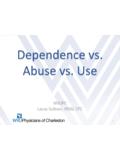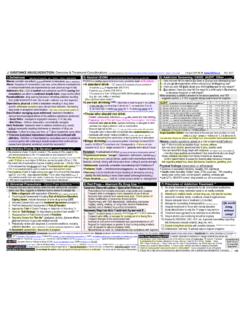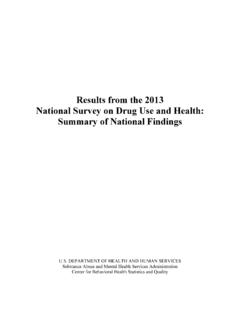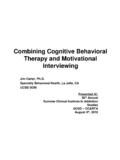Transcription of Facts About Underage Drinking - National Council on ...
1 Facts About Underage DrinkingFacts About Underage DrinkingAlcohol dependence or abuse and Age at First Use Approximately 10% of 9- to 10-year-olds have started Drinking . Nearly one-third of youth begin Drinking before age Persons reporting first use of alcohol before age 15 are more than 5 times as likely to report past-year alcohol dependence or abuse than persons who first used alcohol at age 21 or older (16 vs. 3%).2 Underage Drinking Among College Students An estimated 1,700 college students between the ages of 18 and 24 die each year from alcohol-related unintentional injuries, including motor vehicle crashes.
2 Approximately 600,000 students are unintentionally injured while under the influence of Approximately 700,000 students are assaulted by other students who have been About 100,000 students are victims of alcohol-related sexual assault or date Young adults aged 18 to 22 enrolled full-time in college were more likely than their peers not enrolled full-time ( , part-time college students and persons not currently enrolled in college) to use alcohol in the past month, binge drink, or drink heavily. Past-month alcohol use was reported by of full-time college students compared with of persons aged 18 to 22 who were not enrolled full-time.
3 Binge and heavy-use rates for college students were and , respectively, compared with and , respectively, for 18- to 22-year-olds not enrolled full time in Drinking Among Underage Youth In 2006, About million persons aged 12 to 20 ( of this age group) reported Drinking alcohol in the past month. Approximately million ( ) were binge drinkers, and million ( ) were heavy drinkers. These figures have remained essentially the same since the 2002 When youth drink, they tend to drink intensively, often consuming four to five drinks at one time.
4 Monitoring The Future (MTF) data show that 11% of 8th graders, 22% of 10th graders, and 29% of 12th graders had engaged in heavy episodic or binge Drinking within the past 2 weeks. The National Institute on Alcohol abuse and Alcoholism (NIAAA) defines binge Drinking as a pattern of Drinking alcohol that brings blood alcohol concentration [BAC] to .08 grams or above. For the typical adult, this pattern corresponds to consuming five or more drinks for men, or four or more drinks for women, in About 2 Nationwide, of students had had more than 5 drinks of alcohol in a row ( , within a couple of hours) on more than 1 of the 30 days preceding the survey ( , heavy episodic Drinking ).
5 7 Alcohol Use and Adolescent Development Alcohol is the drug of choice among America s adolescents, used by more young people than tobacco or illicit Children of alcoholics (COAs) are between 4 and 10 times more likely to become alcoholics than children from families with no alcoholic adults. COAs are at elevated risk for earlier onset of Drinking and earlier progression into Drinking Among 8th graders, 30-day prevalence of alcohol use has declined by more than one-third since its peak level in 1996. Among 10th and 12th graders, the proportional declines from recent peaks have been smaller one-sixth among 10th graders since 2000 and one-seventh among 12th graders since In 2006, the prevalence of being drunk at least once in the prior month stands at 6% of 8th graders, 19% of 10th graders, and 30% of 12th Past 30-day prevalence of the use of flavored alcoholic beverages (sometimes called alcopops or malternatives )
6 Was at slightly lower levels in 2006 in all grades than in 2005, having declined by percentage points among 8th graders and percentage points among 12th and Safety Risks of Underage Drinking Underage Drinking is a risk factor for heavy Drinking later in life, and continued heavy use of alcohol leads to increased risk across the lifespan for acute consequences and for medical problems such as cancers of the oral cavity, larynx, pharynx, and esophagus; liver cirrhosis; pancreatitis; and hemorrhagic Underage Drinking is a leading contributor to death from injuries, which are the main cause of death for people under age 21.
7 Annually, About 5,000 people under age 21 die from alcohol-related injuries involving Underage Drinking . About 1,900 (38%) of the 5,000 deaths involve motor vehicle crashes, About 1,600 (32%) result from homicides, and About 300 (6%) result from Youth who report Drinking before the age of 15 are more likely than those who begin Drinking later in life to have other substance abuse problems during adolescence; to engage in risky sexual behavior; and to be involved in car crashes, unintentional injuries, and physical fights after Drinking , both during adolescence and in Underage Drinking plays a significant role in risky sexual behavior, including unwanted, unintended, and unprotected sexual activity, and sex with multiple partners.
8 Such behavior increases the risk for unplanned pregnancy and for contracting sexually transmitted diseases (STDs), including infection with Among the of currently sexually active students nationwide, had drunk alcohol or used drugs before their last incidence of sexual








